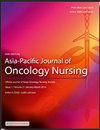中国年轻乳腺癌女性在线健康信息寻求行为模式及相关因素
IF 2.8
3区 医学
Q1 NURSING
引用次数: 0
摘要
目的本研究旨在确定中国年轻乳腺癌女性在线健康信息寻求(OHIS)行为的潜在类别,并研究相关的个人特征,以支持量身定制的健康教育策略。方法2024年4月至9月从中国一家癌症中心招募确诊为乳腺癌的年轻女性。参与者完成了关于人口统计学和临床特征、OHIS行为、社会心理和认知因素、信任、社会规范、沟通和信息寻求经验的问卷调查。潜类分析(LCA)确定了OHIS模式,多变量逻辑回归探索了相关特征。结果在398例患者中,寻求主题的中位数为5(4-7)。与乳腺癌相关的最常见话题包括基本知识(89.7%)、治疗方案(77.6%)和生活方式(75.4%)。近一半的人一个月只搜索几次信息,甚至更少。社交媒体(82.7%)和官方账号/网站(71.1%)是最常用的来源。LCA揭示了三个OHIS行为类别:1类“信息探索者”(26.4%)、2类“偶尔寻求者”(49.2%)和3类“信息专家”(24.4%)。在辅助或其他治疗阶段的患者更可能属于2类而不是1类。那些诊断后时间较长的人也更有可能被归类为2类或3类。相反,I期患者和那些信任在线健康信息的人更有可能属于1级,而更高的电子健康素养与3级会员相关。结论受人口统计学和临床因素的影响,年轻乳腺癌患者OHIS表现多样。认识到这些差异对于提供量身定制的在线卫生信息服务至关重要。本文章由计算机程序翻译,如有差异,请以英文原文为准。
Patterns and associated factors of online health information seeking behaviors among young women diagnosed with breast cancer in China
Objective
This study aimed to identify latent classes of online health information seeking (OHIS) behaviors among young women diagnosed with breast cancer in China and examine associated personal characteristics to support tailored health education strategies.
Methods
Young women diagnosed with breast cancer were recruited from a cancer center in China between April and September 2024. Participants completed questionnaires on demographic and clinical characteristics, OHIS behaviors, psychosocial and cognitive factors, trust, social norms, communication, and information seeking experience. Latent class analysis (LCA) identified OHIS patterns, and multivariate logistic regression explored associated characteristics.
Results
Among the 398 patients, the median number of topics sought was 5 (4–7). The most frequently sought topics related to breast cancer included basic knowledge (89.7%), treatment plans (77.6%), and lifestyle (75.4%). Nearly half sought information only a few times a month or less. Social media (82.7%) and official accounts/websites (71.1%) were the most frequently used sources. LCA revealed three OHIS behavior classes: Class 1 “information explorers” (26.4%), Class 2 “occasional seekers” (49.2%), and Class 3 “information experts” (24.4%). Patients in adjuvant or other treatment phases were more likely to belong to Class 2 than Class 1. Those with a longer time since diagnosis were also more likely to be classified into Class 2 or Class 3. Conversely, stage I patients and those who trusted online health information were more likely to belong to Class 1, while higher eHealth literacy was associated with Class 3 membership.
Conclusions
Young women diagnosed with breast cancer display diverse OHIS patterns influenced by demographic and clinical factors. Recognizing these differences is vital for delivering tailored online health information services.
求助全文
通过发布文献求助,成功后即可免费获取论文全文。
去求助
来源期刊

Asia-Pacific Journal of Oncology Nursing
Multiple-
CiteScore
2.80
自引率
11.10%
发文量
136
审稿时长
31 days
 求助内容:
求助内容: 应助结果提醒方式:
应助结果提醒方式:


